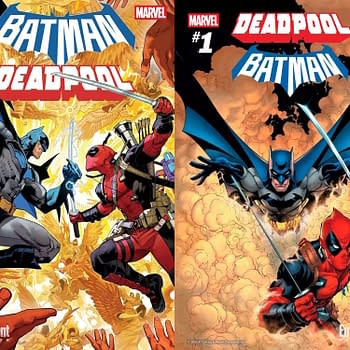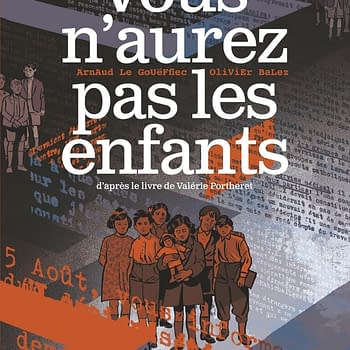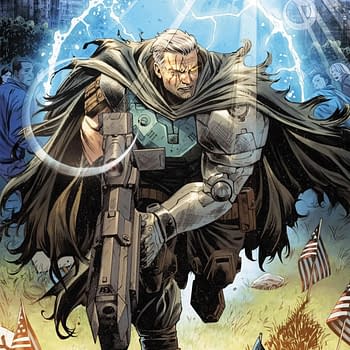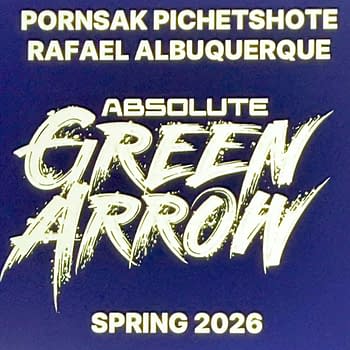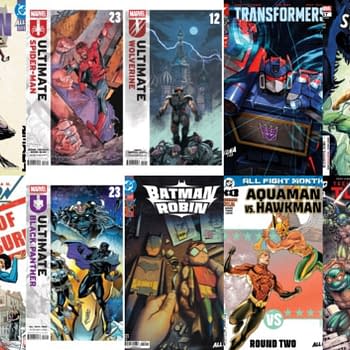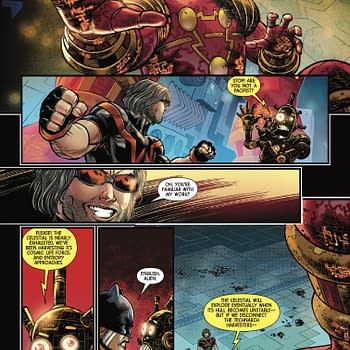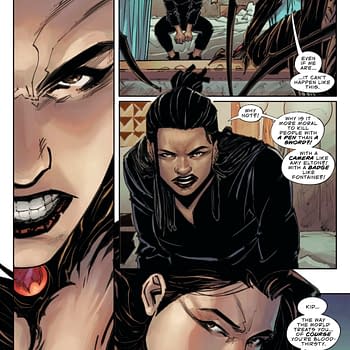Posted in: Comics | Tagged: Comics, HRL
How I Failed To Break Into Comics, And Made Peace With It
Marc Lewis writes:
Hey there. So, you're reading this. Thanks. Let me start by saying that this is not a pity piece. I'm not writing for sympathy. There are so many accounts of how to break into comics. They all end up saying the same thing: work hard, be generous, and gosh darnit, make connections. I thought it would be refreshing to hear from someone who made a go at breaking into comics and failed. (← that would be me.) So, if you're reading this and you're wondering "who the hell is Marc Lewis?" It's cool. You wouldn't know of me. I have roughly five credits to my name. I am going to do my best to tell this chronologically, but it may prove difficult.
The best analogy I can think of to illustrate this journey is baseball. I'll note in this piece where I felt I failed as an Error. When I felt frustrated and let down by my attempts to become a full-time comic artist, I'll note that as a Strike.
So, let's start the recap. In the late 1990s or the early 2000s, I read a sidebar interview in Wizard: The Guide to Comics with an up-and-comer artist that turned me onto the online comics scene. From there, I joined the Millarworld.tv forums. I was going to be the next great penciler. Those hopes were dashed real quick. I was bad. I was real bad. After three years of going at it as a penciler I improved, but I realized that unless I could give more time to my craft I wasn't going to make it. So, I resolved to practice more and to be more critical of myself. Then, my wife told me she was pregnant. I was in my last year of college studying to be a graphic designer. I graduated and lucked into a full-time graphic design position two months later. We started to prepare our son's arrival. One month to the day after 9/11, my oldest son was born.
My daily routine became wake up at 6 a.m., drive to work for 45 minutes, work 8–9 hours, drive home in 45 minutes, family time, stay up until 2 or 3 a.m., sleep and repeat. One year later I was active on multiple boards and constantly drawing. I didn't always submit my drawings online for peer review, but I had stacks of paper with studies of anatomy on them. I got an offer for a job closer to home and I took it. It was an IT job, but had better hours and I could drive to it in 5–7 minutes. I was still drawing until 2 a.m. Things were starting to "click" in my head with my art, but it still felt like I was years behind other artists that were five years younger than me.
Realizing that I needed to find another route into comics I shifted my focus to coloring. I mean I was (and still am) very good with Photoshop, how hard could it be? Oh my goodness, everyone, it's so hard! About this time on a trip to my sister-in-law's in Charlotte I learned of Heroes Con. So, I practiced hard to learn how to color. Around this time my wife gave birth to our second son and I started work with an ad agency. I built a portfolio.
In the summer of 2005, I went to Heroes Con. There I met one of the best people I have ever met. She's been friend and mentor for years. (No, I won't name drop, but she's pretty well known.) She turned me onto yet even more online forums for colorists. So, I practiced. I colored indie projects and submissions too numerous for me to count. I started painting and making my own pieces to print and sell at conventions and entered the convention scene.
The Convention Scene
I regularly attended 4–6 conventions every year from 2006-2013. I had to limit myself to conventions that were near to me (no more than six hours away) because of the time I needed to request off from work. My very first convention was Mid-Ohio con before Wizard bought them. I lost money that weekend and I paid $75 for an Artist Alley table and $100 for a hotel room. Unless you have been on the other side of the table, it's hard to describe that nagging fear in the back of your mind that you won't break even.
I next went to Heroes Con, where a not-so-very-nice man spent five minutes looking through my binder to promptly scoff and tell me that he could do better. Don't misunderstand this to mean I didn't have fun at these events. I did. It always seemed like everyone else was having a better time/show than me. They were drinking until 2 a.m. while I was sleeping on a friend's sofa 30 minutes from the convention center because getting a hotel room meant being hundreds of dollars over budget.
My limitations on bringing a profit home meant I missed out on countless networking opportunities. Looking back, I think I'll call that Error Number 1.
I did cons in western PA, OH, WV, MD, KY, and NC. I used to say Pittsburgh Comic Con was my local con, but Heroes would always be my hometown con. I remember one year at Baltimore Comic Con (this was before they expanded Artist Alley), a High-Profile Colorist (HPC) was in attendance selling prints of their work. These were high quality, large-format, officially Big Two approved prints. I managed to sell an original painting that I finished on the spot on Sunday that saved my entire weekend financially. I passed several tables manned by artists who were trying to "break in" like me and walked to HPC's table. Con goers were buying oodles of low-cost prints (like 8×10 bubble jet prints) from every table. It was a good day in AA — until I got to HPC's table. It was empty of con goers. Here was a colorist that had possibly hundreds of titles in their work history, but appeared to be struggling to sell. This was a very sobering moment for me.
Now, if you've ever been to a convention that I tabled at and walked by me, you probably would remember. I'm like a carnival barker with my "Hey, have you looked at my binder? No? Well, why not? It's free and only takes a minute. No pressure to buy. Promise." I must have said those sentences three hundred or more times. Other artists at tables around me either found it irritating or funny. I'm unapologetic about it. I figured if I sold $20 per every 10th person that visited my table, I could make money and justify investing in attending a con.
Making every convention experience revolve around seeing con goers as a means to make money is what I'll have to call Error Number 2.
Almost Breaking Through
In the fall of 2009 I applied through an online classified ad to color a project for Bluewater Productions. Longtime readers of this site can guess what happened. In short, I colored two issues of Orion the Hunter (#3 and #4) and inked the last five or six of Orion #4, as well. My friends had a party for me to celebrate. Seriously, they baked me a cake! Before the book was published it was sold, though. Poof! There went my 15% of sales. This was Strike 1.
Kids, if you're ever asked to work on a book for a percentage of profit, just walk away. Nearly all of these deals fall through and you won't see any pay and you should always get paid. If a creator/writer isn't serious enough to save money to pay you, then they are not serious enough about their project. I'm sorry, writers: unless you partner with an artist from the beginning, you need to pay your artists. If you're tired of your scripts looking like a complete amateur drew your story, then pay your artists.
From there, I flatted for many Marvel and DC artists. I needed money and good-quality lined art, and it was a good way to get both. I hate doing flats. To me, they were mind-numbing, especially since I wanted to render them and make them pop, but couldn't.
I did more work on indie books, and one day in 2007 or 2008, an old (online) friend of mine responded to a query about work with an offer to color a crossover book between his indie character and rather famous character. While I colored this book, I was coloring a book for a publisher for about $35 less per page than the indie crossover book. Let that sink in for a moment. A publisher was paying me $35 less per page than an indie creator! It was a great experience. We had multiple email interviews across different sites. (You're googling this right now, aren't you?) After some revisions, I still think this was one of my favorite books to have worked on.
In the summer of 2011, I went to NYCC as an attendee on a Pro badge (Hey, I was a credited colorist!). I showed my portfolio to every editor I could find or was introduced to by other artists. I knew chances were small. Most editors at this event are using the time to get face time with their artists, they're not usually interested in finding new talent. I met one editor who opened my eyes. He said I was good, but my approach was too laid back and lazy. He and I discussed a method to get my work in front of as many editors as quickly as possible. (No, I won't disclose the method.)
The method worked, and I finally had a tryout with one of the Big Two. I was sent a package of six inked pages to color and return. I had an open-ended deadline since the person handling me knew I had a full-time job and family. I returned the six pages. Three days later I got rejected via email. I wasn't shocked. They told me things to work on and to submit again in six months. Cool. I made it a point to stay in touch every three weeks or so with a "I thought 'so and so' really blew the latest issue of 'Awesome Comic' out of the water." (Networking, kids. Keeping up relations!)
The week before my time to request a new trial test, the person handling me took another job. I couldn't find out from anyone who I was supposed to talk to now for my follow-up. This was Strike 2.
I never got any closer to working for the Big Two than this. Later on, I learned that the page rate for starting colorists had dropped about 37%. Folks, go thank a colorist when you see one out in the wild or at a con. They are some of the hardest working people in the industry. They typically lose $10 off their page rate for needed flatters because on average, they get around 7–9 days to finish a book and it's near impossible for them to flat and render a full issue in that time period.
Realizations Hit Hard
Looking back, I realize now that from about 2010 through 2013, I wasn't happy. I worked a day job that I couldn't stand anymore. The drive to create new art was hit or miss. I was tired of "working in obscurity." I think people knew this when they saw me. Fellow artists stopped talking to me as much. Con goers would avoid my table. I probably wore a permanent scowl and didn't even realize it. 2012 saw many changes. My wife gave birth to our youngest son. I quit my day job of seven years and took another. I was still miserable, but at least I got out of the environment that made me miserable.
Spring of 2013 found me unemployed for the first time. I didn't have money for conventions or to buy comics. I broke with the industry at first out of necessity and then because I really didn't want to go back to it. I found I didn't miss it. That was Strike 3. Why should I pursue a goal that no longer mattered to me? I still go to one or two conventions every year as an attendee to see old friends. That's the hard part. I miss the friends I made.
My family became my focus. In the fall of 2014 I found a new job and had come to peace with my decision to stop trying to make it in comics. We finished remodeling our house and I started painting with real acrylic paint; brushes, canvas and all.
Is There A Lesson?
The main lesson I learned from my journey is that holding on to something that doesn't drive you might not be the best thing to do. It's difficult to sever the ties you set up to keep you moving towards a goal. If pursuing a goal is affecting your health (I ended up in the ER at one point) or is negatively affecting those you care for ask yourself many times if it's worth it.
Oh, and con goers, be sure to stop by Artist Alley. Take the time to look at the art and talk to the people making the art. Ask commission prices. Spend some money at their table. You'd be surprised how much $10 is worth to an artist staring down a total weekend cost of $500+. Your $10 just moved them closer to their goal of selling enough original art or prints to break even.







